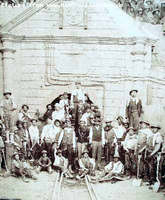Pulacayo
| Pulacayo | ||
|---|---|---|
 Pulacayo Huanchaca Mine around 1880 |
||
| Basic data | ||
| Residents (state) | 816 pop. (2012 census) | |
| height | 4126 m | |
| Post Code | 05-1201-0500-2001 | |
| Telephone code | (+591) | |
| Coordinates | 20 ° 23 ′ S , 66 ° 42 ′ W | |
|
|
||
| politics | ||
| Department | Potosí | |
| province | Antonio Quijarro Province | |
| climate | ||
 Climate diagram Uyuni |
||
Pulacayo is a mining settlement in the Potosí department in the highlands of the South American Andean state of Bolivia .
geography
Pulacayo is the central place of the canton Pulacayo in the municipality of Uyuni in the province of Antonio Quijarro .
The settlement lies at an altitude of 4126 m on the slope of a mountain on the Altiplano . It is located in southwestern Bolivia between the Cordillera de Chichas in the northeast and the Salar de Uyuni salt lake in the west.
The mean average temperature of the region is around 9 ° C (see Uyuni climate diagram), the monthly average temperatures fluctuate between 5 ° C in July and a good 11 ° C from November to March. The annual precipitation is only about 140 mm, with a pronounced dry season from April to November with monthly precipitation below 10 mm, significant precipitation only falls in the months of January and February with monthly values of about 40 mm.
History and mining
The mining area around the Pulacayo Mine (also Huanchaca Mine ) in Huanchaca is located about 20 kilometers east-northeast of the city of Uyuni at an altitude of 4103 m.
The mineral deposits were discovered in 1833. In the 19th century, the Pulacayo mine was the second largest silver mine in Bolivia and reached a depth of around 1100 m until the 1990s . In addition to silver, andorite , diaphorite , Freibergite , galena , miargyrite , pyrargyrite , pyrite , stephanite and tetrahedrite were found in the mine .
In the 19th century a railway line was led to the mine site, possibly the first railway line in Bolivia. Shortly after 1900 the place had 20,000 inhabitants, including 7,000 miners. In the 1940s there were several strikes and attempts to form unions. This movement was bloodily suppressed. The dwellings of the poor miners were separated from those of the rich by fences. The theses proposed by the insurgent workers in 1946 were widely disseminated in Bolivia. In 1952 the mine was nationalized. Soon afterwards the mine was largely exploited. The workers left the place and only a few who remained live on agriculture in an almost ghost town.
Transport network
Pulacayo is located at a distance of 188 kilometers by road southwest of Potosí , the capital of the department and about 19 km from Uyuni .
From Potosí, the Ruta 5 highway leads through the villages of Porco , Chaquilla , Yura and Ticatica to Pulacayo and from there to Uyuni.
population
The population of the town has declined sharply due to the decline of ore mining in the decade before the millennium and has since risen again:
| year | Residents | source |
|---|---|---|
| 1992 | 1,620 | census |
| 2001 | 555 | census |
| 2012 | 816 | census |
Due to the historical population distribution, the region has a significant proportion of Quechua population, in the municipality of Uyuni 43.4 percent of the population speak Quechua .
literature
- Aude de Tocqueville: Atlas of the lost cities . Frederking & Thaler , Munich 2015, ISBN 978-3-95416-179-9 .
Individual evidence
- ^ Mineralienatlas: Mineralienportrait / Silber / New World - Bolivia
- ↑ Mineralienatlas: Huanchaca - locality and mineral find list ( page no longer available , search in web archives ) Info: The link was automatically marked as defective. Please check the link according to the instructions and then remove this notice.
- ^ INE - Instituto Nacional de Estadística Bolivia 1992
- ^ INE - Instituto Nacional de Estadística Bolivia 2001
- ↑ INE - Instituto Nacional de Estadística Bolivia 2012 ( Memento of the original from July 22, 2011 in the Internet Archive ) Info: The archive link has been inserted automatically and has not yet been checked. Please check the original and archive link according to the instructions and then remove this notice.
- ↑ INE social data Potosí 2001 (PDF; 5.5 MB)
Web links
- Relief map of the Uyuni region 1: 250,000 (PDF; 11.19 MB)
- Municipio Uyuni - detailed map and population data (PDF; 1.79 MB) (Spanish)
- Municipio Uyuni - General Maps No. 51201
- Department Potosí - social data of the municipalities ( Spanish ) (PDF; 5.23 MB)
